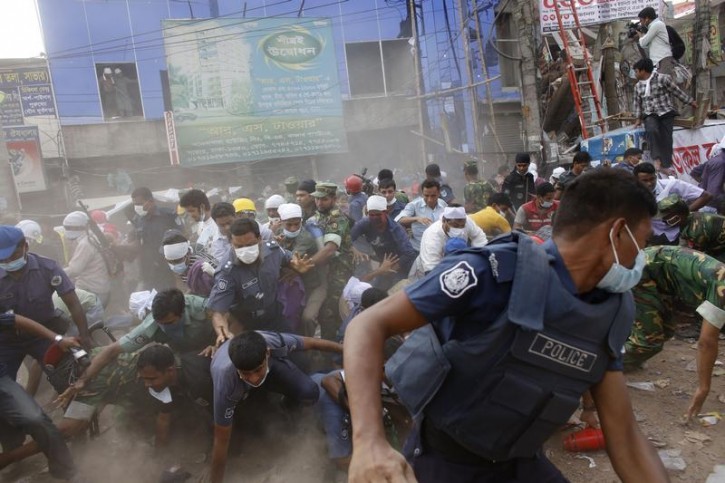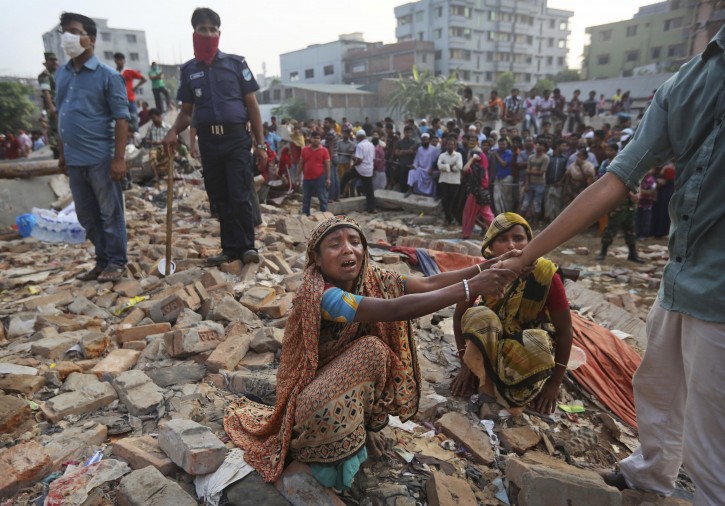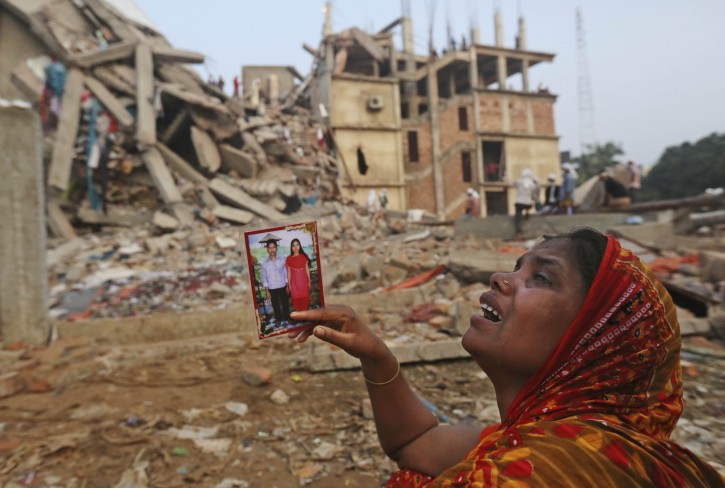 Savar, Bangladesh – More than two days after their factory collapsed on them, at least some garment workers were still alive in the corpse-littered debris Friday, pinned beneath tons of mangled metal and concrete. Rescue crews struggled to save them, knowing they probably had just a few hours left to live, as desperate relatives clashed with police in their anger and grief.
Savar, Bangladesh – More than two days after their factory collapsed on them, at least some garment workers were still alive in the corpse-littered debris Friday, pinned beneath tons of mangled metal and concrete. Rescue crews struggled to save them, knowing they probably had just a few hours left to live, as desperate relatives clashed with police in their anger and grief.
Subscribe to our Daily Roundup Email
Amid the chaos, the cries for help and the smell of decaying bodies at the eight-story building where more than 300 died, what happened to 18-year-old Mussamat Anna passes as luck. Rescue workers cut off the garment worker’s mangled right hand to pull her free from the debris Thursday night.
“First a machine fell over my hand and I was crushed under the debris. … Then the roof collapsed over me,” she told an Associated Press cameraman from a hospital bed Friday.
The death toll topped 300 on Friday and it remained unclear what the final grim number would be. Military spokesman Shahin Islam told reporters that 304 bodies had been recovered.
Brig. Gen. Mohammed Siddiqul Alam Shikder, who is overseeing rescue operations, said 2,200 people have been rescued. The garment manufacturers’ group said the factories in the building employed 3,122 workers, but it was not clear how many were inside it when it collapsed Wednesday in Savar, a suburb of Bangladesh’s capital, Dhaka.
An army rescue worker, Maj. Abdul Latif, said Friday that he found one survivor still trapped under concrete slabs, surrounded by several bodies. At another place in the building, four survivors were found pinned under the debris, a fire official said. An Associated Press cameraman who accompanied a rescue crew heard two men’s anguished cries for help; it was unknown Friday whether they were still alive.

Rescue workers said they were proceeding very cautiously inside the crumbling building, using their hands, hammers and shovels, to avoid more injuries and collapses. But they said the trapped workers were so badly hurt and weakened that they would need to be extricated within a few hours if they are to survive.
A military official, Maj. Gen. Chowdhury Hasan Suhrawardy, told reporters that search and rescue operations would continue until at least Saturday.
“We know a human being can survive for up to 72 hours in this situation. So our efforts will continue non-stop,” he said.
Hundreds of rescuers, some crawling through the maze of rubble, spent a third day working amid the cries of the trapped and the wails of workers’ relatives gathered outside the building, which housed numerous garment factories and a handful of other companies.

Police cordoned off the building site, pushing back thousands of bystanders and relatives, after rescue workers said the crowds were hampering their work.
Clashes later erupted between relatives of those still trapped and police officers, who used batons to disperse the mobs. Police said 50 people were injured in the clashes.
“We want to go inside the building and find our people now. They will die if we don’t find them soon,” said Shahinur Rahman, whose mother is missing.
Elsewhere, many thousands of workers from the hundreds of garment factories across the Savar industrial zone and other nearby industrial areas took to the streets to protest the collapse and poor safety standards.
Local news reports said protesters had smashed dozens of vehicles at one strike Friday. Most of the other protests were largely peaceful.
Dozens of people have been rescued from the wreckage well after Wednesday morning’s collapse.
Forty people had been trapped on the fourth floor of the Rana Plaza building until rescuers reached them Thursday evening. Twelve were soon freed, and crews worked to get the others out safely, said Brig. Gen. Shikder. Crowds at the scene burst into applause as survivors were brought out.
Police say cracks in the building had led them to order an evacuation Tuesday, but the factories ignored the order and were operating when it collapsed Wednesday. Video shot before the collapse shows cracks in the walls, with apparent attempts at repair. It also shows columns missing chunks of concrete and police talking to building operators.

Officials said soon after the collapse that numerous construction regulations had been violated.
Abdul Halim, an official with Savar’s engineering department, said the owner of Rana Plaza was originally allowed to construct a five-story building but added another three stories illegally.
Home Minister Muhiuddin Khan Alamgir has said the building violated construction codes and that “the culprits would be punished.” Local police chief Mohammed Asaduzzaman said police and the government’s Capital Development Authority have filed separate cases of negligence against the building’s owner.
Habibur Rahman, police superintendent of the Dhaka district, identified the owner of the collapsed building as Mohammed Sohel Rana, a local leader of ruling Awami League’s youth front. Rahman said police were also looking for the owners of the garment factories.
The disaster is the worst ever for Bangladesh’s booming and powerful garment industry, surpassing a fire five months ago that killed 112 people and brought widespread pledges to improve the country’s worker-safety standards.
Instead, very little has changed in Bangladesh, where wages, among the lowest in the world, have made it a magnet for numerous global brands.

Bangladesh’s garment industry was the third-largest in the world in 2011, after China and Italy. It has grown rapidly in the past decade, a boom fueled by Bangladesh’s exceptionally low labor costs. The country’s minimum wage is now the equivalent of about $38 a month.
Among the garment makers in the building were Phantom Apparels, Phantom Tac, Ether Tex, New Wave Style and New Wave Bottoms. Altogether, they produced several million shirts, pants and other garments a year.
The New Wave companies, according to their website, make clothing for several major North American and European retailers.
Britain’s Primark acknowledged it was using a factory in Rana Plaza, but many other retailers distanced themselves from the disaster, saying they were not involved with the factories at the time of the collapse or had not recently ordered garments from them.
Wal-Mart said none of its clothing had been authorized to be made in the facility, but it is investigating whether there was any unauthorized production.
U.S. State Department spokesman Patrick Ventrell said the collapse underscored the “urgent need” for the Bangladesh government, as well as the factory owners, buyers and labor groups, to improve working conditions in the country.
Human Rights Watch says Bangladesh’s Ministry of Labor has only 18 inspectors to monitor thousands of garment factories in the sprawling Dhaka district, where much of the nation’s garment industry is located.
John Sifton, the group’s Asia advocacy director, also noted none of the factories in the Rana Plaza were unionized, and had they had been, workers would have been in a better position to refuse to enter the building on Wednesday.


This is reminiscent of the Triangle fire.